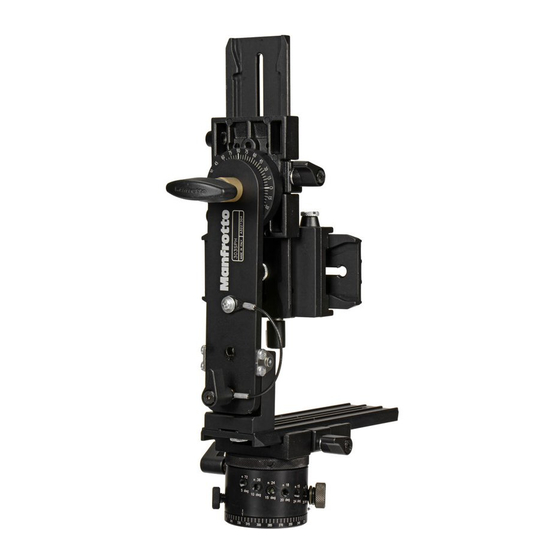
Manfrotto 303SPH Bedienungsanleitung
Vorschau ausblenden
Andere Handbücher für 303SPH:
- Bedienungsanleitung (50 Seiten) ,
- Kurzanleitung (18 Seiten)
Werbung
Verfügbare Sprachen
Verfügbare Sprachen
Quicklinks
Werbung

Inhaltszusammenfassung für Manfrotto 303SPH
- Seite 1 INSTRUCTIONS 303SPH...
- Seite 3 INDEX Pag. 4 - 11 “ 12 - 19 “ 20 - 27 “ 28 - 35 “ 36 - 43...
- Seite 20 Funktionen erfüllen. Sofern das verwendete Stativ nicht über eine eingebaute Nivelliervorrichtung verfügt (wie etwa die Halbkugel 50 mm des Manfrotto Stativs MdeVe), ist zur präzisen Nivellierung des Kopfes eine der Nivelliervorrichtungen aus dem Manfrotto Programm erforderlich (siehe Punkt 1).
- Seite 21 BEFESTIGUNG DER KAMERA Entfernen Sie das Oberteil (Abb. 2) nach Lösen der Klemme "D”. Zur völligen Entnahme drücken Sie den Sperrknopf “E”. Lösen Sie die Klemme "G", und entfernen Sie die Einstellschlitten “CP” (Abb. 3). Zur völligen Entnahme drücken Sie den Sperrknopf "H". Am Oberteil finden Sie zwei Anziehschrauben: "J"...
- Seite 22 ANMERKUNG Die Stellung der Führung “M” zum langen Schlitten “F” erfordert eine Justierung: Lösen Sie die Schraube “O”, und verschieben Sie die Einheit. Im Idealfall befindet sich die Kamera so weit hinten auf dem Schlitten wie möglich, bevor die Vorderkante “N” des langen Schlittens “F” im Gesichtsfeld "P" der Kamera sichtbar wird. ANBRINGEN DER KAMERA AM KOPF Befestigen Sie das gesamte Oberteil mit Kamera wie in Abb.
- Seite 23 VERTIKALE KAMERAAUSRICHTUNG Sollte die Kamera nicht perfekt in der vertikalen Achse (Abb. 7b) ausgerichtet sein, kann diese mit Madenschraube „GS“ justiert werden. UNGEFÄHRE AUSRICHTUNG AUF DEN KNOTENPUNKT (Abb. 8): Richten Sie die Aufnahmeachse "Q" der Kamera unter Bezug auf die Markierung CENTER auf dem Schlitten auf die Drehachse "Q" aus. Hierzu lösen Sie den Knopf "R"...
- Seite 24 PRÄZISE AUSRICHTUNG 10 11 DES KNOTENPUNKTES Enthält das Motiv unterschiedlich weit entfernte Details, muss der Knotenpunkt wie folgt präziser ausgerichtet werden (dieses Verfahren ist AUSSCHLIESSLICH mit Spiegelreflexkameras möglich): Anmerkung: NEHMEN SIE ALS ERSTES DIE LÄNGSAUSRICHTUNG VOR DIE SEITENAUSRICHTUNG DARF ERST NACH DER LÄNGSAUSRICHTUNG ERFOLGEN.
- Seite 25 SEITENAUSRICHTUNG (Abb. 11): Wählen Sie einen Ausschnitt, der auf derselben Horizontalachse sowohl ein Nahobjekt "1" als auch ein Fernobjekt "2" enthält. (Siehe Abb. 11A und 11B): Lösen Sie Klemme "AF", und schwenken Sie die Kamera um die Panorama-Achse, so dass sich die beiden Motivdetails einmal am linken, danach am rechten Bildrand befinden.
- Seite 26 HINWEISE FÜR KUGELBILDAUFNAHMEN Ein Kugelbild entsteht durch Aneinanderfügen von Panorama-Aufnahmen, die mit unterschiedlichen Winkeln zur Horizontalen gemacht wurden. Zunächst ermittelt man hierfür die Anzahl von Panorama-Aufnahmen, die in Abhängigkeit vom Bildwinkel des Aufnahmeobjektivs zur Erzielung eines Kugelbildes erforderlich sind. Vor Beginn der Panorama-Aufnahmen ermittelt man mit Hilfe der Skala "Z" den vertikalen Startwinkel (Abb. 12). Lösen Sie die Klemme "AF";...
- Seite 27 CENTER FC/FS CENTER ZUSÄTZLICHE EINSTELLSCHLITTEN Für den Einsatz sehr kompakter Kameras empfehlen wir die Verwendung der kurzen Schlitten "SC" (Abb. 13) und "FC" (die zum Lieferumfang gehören) anstelle der beiden langen Schlitten "F" und "S", um Volumen und Gewicht der Ausrüstung zu verringern. Zum Austausch von Schlitten "S"...
- Seite 44 Cod. 303,14 - 06/06 Copyright © 2004 Manfrotto Bassano Italy...















